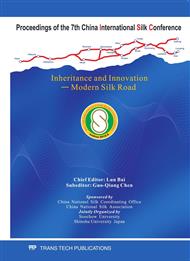p.95
p.100
p.105
p.110
p.116
p.121
p.127
p.132
p.137
Expression of EGFP-Spider Dragline Recombination Gene in BmN Cells Using piggyBac Transposon-Derived Vector
Abstract:
A transformation system was developed for stable germline transformation in the silkworm Bombyx mori L. using piggyBac, a transposon discovered in the lepidopteran Trichoplusia ni, and a helper plasmid. The transposon consists of the piggyBac inverted terminal repeats, the enhanced green fluorescent protein gene as the reporter gene and the spider dragline gene. A nonautonomous helper plasmid encodes the piggyBac transposase. The transformation system was cotransfected into BmN (Bombyx mori L. Nucleopolyhedrovirus) cells using lipofection. PCR amplification on cellular genomic DNA using specific primers showed that a fragment of reporter gene, the spider dragline derived gene and A3 promoter were successfully amplified respectively. Plasmids without being transpositioned were not assayed. Green fluorescence cells were observed at 48 hours after transfection and the fluorescence intensity increased at 72 hours after transfection.
Info:
Periodical:
Pages:
116-120
Citation:
Online since:
January 2011
Authors:
Keywords:
Price:
Сopyright:
© 2011 Trans Tech Publications Ltd. All Rights Reserved
Share:
Citation:


